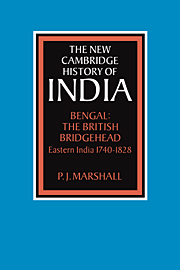Book contents
- Frontmatter
- 1 The setting for empire
- 2 Late Mughal Bengal
- 3 The crisis of empire, 1740–65
- 4 The new regime
- 5 A new society?
- 6 Conclusion
- Bibliographical Essay
- Index
- THE CAMBRIDGE HISTORY OF INDIA
- Map 1 Eastern India, 1740–1828: places mentioned in the text
- Map 2 Eastern India, 1740–1828: economic
- Plate Section">
- References
2 - Late Mughal Bengal
Published online by Cambridge University Press: 28 March 2008
- Frontmatter
- 1 The setting for empire
- 2 Late Mughal Bengal
- 3 The crisis of empire, 1740–65
- 4 The new regime
- 5 A new society?
- 6 Conclusion
- Bibliographical Essay
- Index
- THE CAMBRIDGE HISTORY OF INDIA
- Map 1 Eastern India, 1740–1828: places mentioned in the text
- Map 2 Eastern India, 1740–1828: economic
- Plate Section">
- References
Summary
Even in the eighteenth century, provinces of the Mughal empire were in theory part of a fully integrated imperial system. The provincial government was manned by men who were loyal to the empire, not to the province where they happened to serve. Senior office holders owed their appointments to the Emperor and lost them at his pleasure, when they were dismissed or transferred to other provinces. A large part of the financial resources of any province was either allocated to support imperial service through the system of jagirs, grants of revenue for the upkeep of troops or distinguished individuals, or remitted to the imperial treasury.
When Alivardi Khan became Governor of Bengal, Bihar and Orissa in 1740, these areas were still provinces of the Mughal empire, but the way in which they were governed bore little resemblance to the system outlined above. Alivardi Khan ruled a virtually autonomous state. He seized his position by force, subsequently gaining imperial endorsement, and he filled offices at his own discretion, even if he sought imperial ratification for most of them later. The resources of Bengal itself were no longer allocated in imperial jagirs, although these survived in Bihar and Orissa. Earlier in the eighteenth century, money had gone from Bengal to the imperial treasury in great quantities; in Alivardi Khan's ‘reign’ the flow of tribute became very irregular. The links binding the three provinces to the imperial centre, itself seriously weakened, had become very tenuous. An independent state was in the making.
- Type
- Chapter
- Information
- Bengal: The British BridgeheadEastern India 1740–1828, pp. 48 - 69Publisher: Cambridge University PressPrint publication year: 1988

